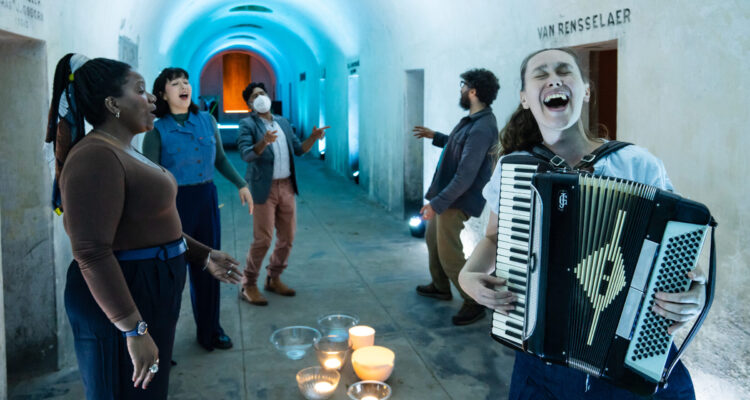On one of the first nights in September with a whisper of chill in the air, a group sets out into the darkness of Green-Wood Cemetery in Brooklyn. Following a swinging lantern (the only light source other than the moon), we walk twenty or so minutes into the heart of the enormous cemetery before we reach the Catacombs: the venue for Death of Classical’s latest offering. If there ever was a performance to be held in a catacomb, it would be this modern opera, stylized as mɔɹnɪŋ, also known as morning//mourning.
mɔɹnɪŋ, composed by creator and performer Gelsey Bell, tells the story of life on Earth after the disappearance of humans. Based on the book The World Without Us by Alan Weisman, the story essentially begins at our end. If all humans on the planet miraculously disappeared, what would the world look like an hour later? A day later? 30 years later? An eon?
The Catacombs at Green-Wood are a long and narrow space full of doors that lead to separate crypts, and tonight it is all lit up by blue light. As we wait for the show to begin, an unnatural silence – unnatural, that is, for New York City – descends over the catacombs like a weight. When the performers step from the darkness of the crypt doors and begin Part 1 of the piece, a heart-wrenching, goosebumps-raising keening unique to each character, it really does feel like we are at the end of the world as we know it. But the show quickly moves from this mournful space to a playful, dare I say hopeful, one.
“What we’re doing in Green-Wood is an abridged version [of the full show originally performed at HERE Arts Center] that’s really focusing on the songs and the vocal work… mostly because the catacombs is a really wonderful place to listen to music, but it’s not a place where you put on plays. There’s no sound system, things like that. So we’ve really focused on the parts of the show that we think shine the most in that space,” says Gelsey Bell.
The Catacombs version of mɔɹnɪŋ strikes a beautiful balance between storytelling and letting the evocative music of the piece speak for itself. All five performers throw themselves into the music, and they are intoxicating to watch. They weave the future we’ll never get to see, first in decades at a time, and then millennia. The story is about ceasing to exist, but it’s also about the infinite possibilities of new life – and the eventual, inevitable understanding that absolutely nothing will last forever.
Death of Classical’s mission of presenting concerts in crypts may have a certain memento mori quality to it, but Bell’s creation almost seems meant for a venue like this. The experience of pondering life after our existence while surrounded by the tombs of long-gone New Yorkers is quite a unique one. And as far as memento mori go, mɔɹnɪŋ might just be the most delightful, gentle telling of the end of the world you’d care to come across.
“There’s no question that mortality is a big part of the piece. Whenever you do something in a cemetery, you are surrounded by mortality. You don’t need to name it because it’s just so present,” says Bell. “Green-Wood is an incredible natural space. To have such a range of tree life, plant life, animal life, in the middle of New York City is really special…That very much plays into the importance of the piece, of really listening to non-human stories – to the stories of animals, of plants, of other aspects of the ecosystem beside the humanity-focused one. Humans are talked about in the piece, don’t get me wrong. But it’s a mix of both.”
Bell’s enchanting composition builds the story up, each eon more magical than the next, until the inevitable – the Earth itself begins to decline, as science has always told us that it will some day. This somber ending to the piece, which has been full of such violence and yet such joy, is the most predictable, and yet somehow the most mournful. This, it seems, is the memento mori – not the disappearance of us, but that of the planet that has remained the one constant in this theoretical future: a death so far away that it’s not even a consideration in the tiny life of our species. Bell’s storytelling takes us fully out of ourselves like omnipotent gods, only to remind us of our humanity.
Bell’s Catacombs-specific presentation of mɔɹnɪŋ coincides with the release of the full album for purchase on Bandcamp. “I’m really excited to have the album out there,” says Bell. “Especially with experimental work like this [with very limited runs], there are a lot of people that I would like to hear the work that I know can’t be in New York. I’m hoping that having the album means it can be enjoyed by more people.” A show so emotionally pervasive and musically resonant deserves to be preserved and shared, even if its message is that its destiny – like the human race, our accomplishments, and our planet – is to fade to the ravages of time.
Composed, staged, and libretto by Gelsey Bell
With consultation by Tara Ahmadinejad
Lighting consultation by Masha Tsimring
Cast includes: Gelsey Bell, Aviva Jaye, Brian McCorkle, Mia Pak, Paul Pinto
The Catacombs in Green-Wood Cemetery
Photo credit: Steve Pisano

